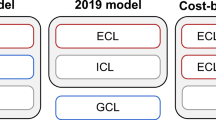Abstract
The Internet is an integral part of the lives of our children nowadays. Using the Internet, in particular search engines, children search for information for school, for their individual interests or simply for entertainment. Unfortunately, research shows that children face many difficulties when searching and browsing for information, even though there are several search engines that are designed especially for children. In this paper, we review recent work in this field and evaluate to what extent current search engines for children are appropriately supporting the motor and cognitive skills of elementary school-age children. We base our study on findings of previous research and derive criteria to assess existing search engines. Our results suggest that most of them still require improvements in order to fit the skills and competencies of children.









Similar content being viewed by others
Notes
KIM is a German acronym for Children and Media (“Kinder + Medien, Computer + Internet”).
These numbers indicate the subjective feeling of success and may be falsely overestimated.
Elementary-age children are approximately in the beginning of Piaget’s concrete operational stage of development. In this stage, children begin to reason logically, but their understanding is limited to concrete and physical concepts (in contrast to abstract ones).
The monitor resolution used in their study was 1,024 × 768 pixels. We used a resolution of 1,366 × 768 pixels on a 16:9 display in our study.
The targets used in the study were circles.
References
Akkersdijk SM, Brandon M, Jochmann-Mannak HE, Hiemstra D, Huibers TW (2011) ImagePile: an alternative for vertical results lists of IR-systems. Technical report TR-CTIT-11-11, Centre for Telematics and Information Technology, University of Twente (ISSN 1381–3625)
Bilal D (2000) Children’s use of the Yahooligans! Web search engine: I. Cognitive, physical, and affective behaviors on fact-based search tasks. J Am Soc Inf Sci 646–665
Bilal D, Kirby J (2002) Differences and similarities in information seeking: children and adults as Web users. Inf Proc Manag 649–670
Borgman CL, Hirsh SG, Walter VA, Gallagher AL (1995) Children’s searching behavior on browsing and keyword online catalogs: the Science Library Catalog project. J Am Soc Inf Sci 663–684
Chi MT (1976) Short-term memory limitations in children: capacity or processing deficits? Mem Cogn 559–572
Erikson EH (1963) Childhood and society. W. W. Norton & Company, New York
Gilutz S, Nielsen J (2002) Usability of websites for children: 70 design guidelines. Nielsen Norman Group, Freemont
Gossen T, Low T, Nürnberger A (2011) What Are the real differences of children’s and adults’ web search? In Proceedings of the 34rd annual ACM SIGIR conference on research and development in information retrieval (SIGIR’11), 1115–1116. ACM
Gyllstrom K, Moens MF (2010) A picture is worth a thousand search results: finding child-oriented multimedia results with collAge. In: Proceedings of the 33rd annual ACM SIGIR conference on research and development in information retrieval, 731–732. ACM
Hackfort D (2003) Studientext Entwicklungspsychologie 1: theoretisches Bezugssystem, Funktionsbereiche, Interventionsmöglichkeiten. Vandenhoeck & Ruprecht, Göttingen
Hearst MA (2009) Search user interfaces. Cambridge University Press, Cambridge
Hourcade JP, Bederson BB, Druin A, Tière FG (2003) Accuracy, target reentry and fitts’ law performance of preschool children using mice. University of Maryland Technical Report, HCIL-2003
Hutchinson H, Druin A, Bederson BB, Reuter K, Rose A, Weeks AC (2005) How do I find blue books about dogs? The errors and frustrations of young digital library users. Proceedings of HCII 2005
Jansen M, Bos W, van der Vet P, Huibers T, Hiemstra D (2010) TeddIR: tangible information retrieval for children. In: Proceedings of the 9th international conference on interaction design and children, pp 282–285. ACM
Jochmann-Mannak H, Huibers T, Lentz L, Sanders T (2010) Children searching information on the Internet: Performance on children’s interfaces compared to Google. In: Workshop of the 33rd annual international acm sigir conference on research and development in information retrieval, pp 27–35
Large A, Beheshti J (2000) The Web as a classroom resource: reactions from the users. J Am Soc Inf Sc 1069–1080
Large A, Beheshti J, Rahman T (2002) Design criteria for children’s Web portals: the users speak out. J Am Soc Inf Sci Technol 79–94
Lefrancois GR (1995) Of Children: an introduction to child development. Wadsworth Publishing Company, Stamford
Medienpädagogischer Forschungsverbund Südwest (2011) KIM-Studie 2010, Kinder + Medien, Computer + Internet, Basisuntersuchung zum Medienumgang 6- bis 13-Jähriger in Deutschland. Stuttgart: Medienpädagogischer Forschungsverbund Südwest
Naidu S (2005) Evaluating the usability of educational websites for children. Usability News
Nielsen J (2010) Children’s websites: usability issues in designing for kids. Jakob Nielsen’s Alertbox
Oxford University Press. Oxford Dictionaries. Retrieved on 26. 09. 2011 from http://oxforddictionaries.com/definition/cognition
Piaget J, Inhelder B (1969) The psychology of the child. Basic Books, New York
Polajnar T, Glassey R, Gyllstrom K, Azzopardi L (2011) Enabling picture-based querying and learning with the JuSe interface. In: Proceedings of the 2nd child computer interaction: workshop on UI technologies and educational pedagogy at CHI
Sluis F, van den Broek EL, van Dijk B (2010) Information retrieval experience (IRX): towards a human-centered personalized model of relevance. In: 2010 IEEE/WIC/ACM international conference on web intelligence and intelligent agent technology, 322–325. IEEE
Strommen E (1994) Children’s use of mouse-based interfaces to control virtual travel. In: Proceedings of the SIGCHI conference on human factors in computing systems: celebrating interdependence, 405–410
Stuart A (2007) http://children.webmd.com. Retrieved on 28. 09. 2011 from http://children.webmd.com/features/when-should-kids-learn-read-write-math
Author information
Authors and Affiliations
Corresponding author
Rights and permissions
About this article
Cite this article
Gossen, T., Hempel, J. & Nürnberger, A. Find it if you can: usability case study of search engines for young users. Pers Ubiquit Comput 17, 1593–1603 (2013). https://doi.org/10.1007/s00779-012-0523-4
Received:
Accepted:
Published:
Issue Date:
DOI: https://doi.org/10.1007/s00779-012-0523-4




